Preventing the suicidal behaviour in children and adolescents.
Preventing the suicidal behaviour in children and adolescents.
J. l. Pedreira Massa*; G. Lahera Forteza**.
* University Children’s hospital Niño Jesús. Autonomous University of Madrid
** University hospital Príncipe de Asturias. University of Alcalá de Henares (Madrid)
Suicidal behaviour in children and adolescents: Introduction
•Public health problem: rate 76, 5/100. 000 (2nd cause of death in adolescence, WHO)
•Male > female (2:1)
•Methods: pharmacologic intoxication, hanging, firearms.
•> 15 years old
•Exceptional < 10 yo
•Produces 40% of the paidopsychiatric hospitalisations
Concepts
Rene F. W. Diekstra. WHO-Europe (1992):
1) Suicide: Operational criteria
•Definition:
–Fatal outcome
–Self-initiation of act that leads to this outcome
–Knowledge of actor that action he iniciates to produce the objective state of death
•Considerations:
–Intent to die not necessary
–Fatal outcome short term effect of act
–Terminal condition does not exclude suicide
•Inclusion:
–Terrorist “suicide” and drug “overdose” in addicts
•Exclusion:
–Grandiose-megalomaniac acting-out in psychosis
–“Suicidal erosion” (to be scored as Including Self Mutilation Disorder)
2) Attempted Suicide: Operational criteria
•Definition:
–Non-fatal outcome
–Self-initiation of act that would have led to fatal outcome if not for. . .
–Knowledge or expectation of actor that action he iniciates tends to produce the objective state of death
•Considerations:
–Intent to die not necessary
–Terminal condition does not exclude suicide
–Medical seriousness not decisive
–Conditions to be formulated per method
•Inclusion:
–Evidence of knowledge has to be available
–Terrorist “attempt” and drug “overdose” in addicts
–Nonhabitual alcohol overdose
•Exclusion:
–Grandiose-megalomaniac acting-out in psychosis
–“Suicidal erosion” (to be scored as Including Self Mutilation Disorder)
–Habitual act
3) Parasuicide: Operational criteria
•Definition:
–Non-fatal outcome
–Self-initiation of act that leads to selfharm or ingestion af a substance in excess of the generally recognized therapeutic dosage (or will do so if not for. . . . )
–Knowledge of actor that action he iniciates tends to produce objective selfharm or overdosage of substance
•Inclusion:
–“Manipulative” acts, conditions to be formulated per method
–Cluster of parasuicidal acts
–Acute alcohol intoxication
–Evidence of knowledge has to be available specific motive irrelevant (e. g. wanting to sleep)
•Exclusion:
–Habitual Behaviour (Including Self Mutilation Disorder)
4) Self mutilation / self injury behavior
•“The act of attempting to alter a mood state by inflicting physical harm serious enough to cause tissue damage to one's body”
•cutting, burning, and head-banging
•It is a maladaptive coping mechanism, in an attempt to maintain psychological integrity
Complexity of the research in suicide causes
•Phisiological predisposition
•Cultural context
•Socioeconomic context
•Interpersonal context
•Personal characteristics
•Use/abuse of desinhibitors
•Presence of marginal behaviours
•Presence or absence of saviours
¿What to do with the current scientific data?
To banish the idea of direct PREDICTION. It has no conceptual nor methodological support.
•PREVENTION: difficult, complex, but possible. Requires qualified human and material resources.
•Prevention programs: variable results.
Best in Netherlands, with a real decrease in adolencence suicide rate
Towards a Comprehensive Strategy for the Prevention of Suicide Behaviour
Rene F. W. Diekstra. WHO-Europe (1992); J. L. Pedreira (1993, 1995 y 1998)
1) Research
•Collection of national and international data on the incidence of suicide:
–International adoption of uniform definitions and operational criteria (suicide, suicide attempt and parasuicide)
–Data collection for analytical-epidemiological studies–Data collection → prevention or intervention programs can be tested
–General Hospitals and other medical or social services >> to maintain records of these cases
•Designing multidisciplinary international research programs:
Study the INTERACTION between multiple risk factors (emotional disturbance, alcohol and drug abuse, biological enviromental and cultural factors)
•Well-planned research studies using control groups
•Conducting studies to determine the most effective and safe way of informing the public about suicide
2) Improving Services
•Increased competence of professionals:
–Information and training:
•on the epidemiology of suicide and attempted suicide and the risk factors for suicidal behaviour
•in the skill necessary to identify people with a high-risk of suicidal behaviour
• in interview techniques, treatment and after-care of suicidal people and also with families and friends
•in the appropriate referral of suicidal people to appropriate health care professionals and agencies
•More specific and better coordinated ASISTANCE/AFTER-CARE to suicidal people and their relatives:
–The provision of direct and specific assistance and intervention in crisis situations
–Making thorough assessments of suicide risk and appropriate plans for treatment
–Referral and transfer of suicidal people to other services and the provision of appropriate help and aftercare
•To incorporate clinical psychiatric and psychological knowlege, skills and expertise in crisis intervention
•Facilities for prolonged observation of suicidal persons in hospitals, even when medical treatment has ended
3)Training and Information
•Curricula of primary and secondary school teachers and counsellors:
–Information on:
•the acute and chronic risk factors associated with suicidal behaviour
•the characteristic symptoms of depression and other psychological disturbances
•criteria and methods for referral of students who are clearly at risk and identification of referral institutions
–Training in:
•interpersonal and communication skills necessary to approach and stablish an understanding relationship with such pupils
•The role of EMERGENCY TELEPHONE SERVICES and their potential in suicide prevention:
–To investigate optimal use to prevent suicide: the training of volunteers workers, the relationship with agencies providing assistance, the linkages to mental health professionals
–To study the long-term follow-up of suicidal persons who have contacted emergency telephone services
•To the general public: to increase awareness of the symptoms of depression and other warning signs of suicide.
•The media:
–should exercise great prudence and restraint in publishing new items concerning suicide
–discussion with professional experts in suicide
4)Adolescents: Special group
•Provisions organized:
–School-attending adolescents:
•collaboration between schools and primary mental health services; parents should be involved
•a psychiatrist or psychologist to consult at the school
–If the youngsters not attending school:
•Special community outreach activities should be established
•More research in correctional institutions•To identify and to discuss suicidal thoughts and plans with chonically ill patients
–To acceptance of illness or disability
–The extent an acceptable quality of life, given the disability
–To be trained in counselling such patients or in appropriately referring them
•To combat alcohol and drug abuse
•Relatives of people who have committed suicide: at high risk group
Conclusions
•Suicide in Adolescence is a serious international public health problem
•Suicide and attempted suicide can be prevented
•The organizational structures required for well-coordinated programs of research and practice in the area of suicide prevention are only beginning
•Adequate training of health care professionals and other relevant groups in the assessment and management of suicide risk is lacking
IMPORTANTE: Algunos textos de esta ficha pueden haber sido generados partir de PDf original, puede sufrir variaciones de maquetación/interlineado, y omitir imágenes/tablas.

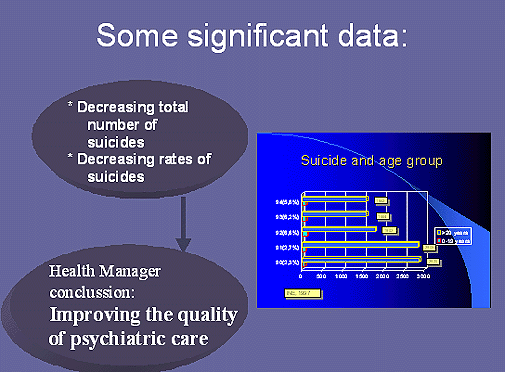
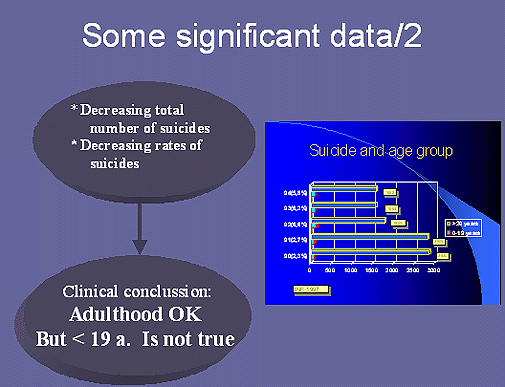
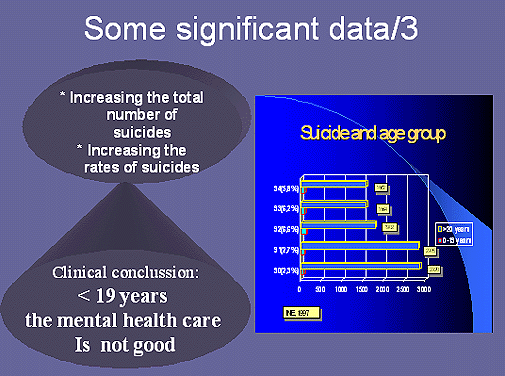



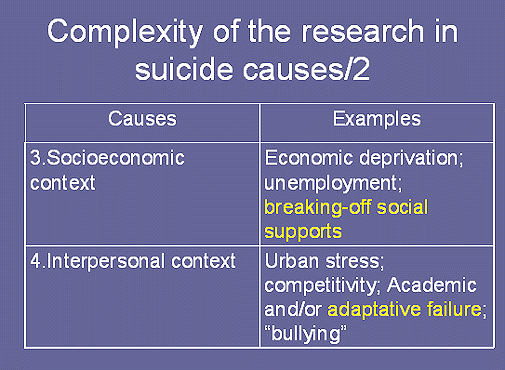
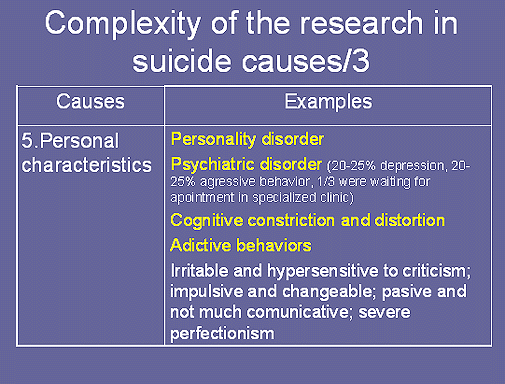
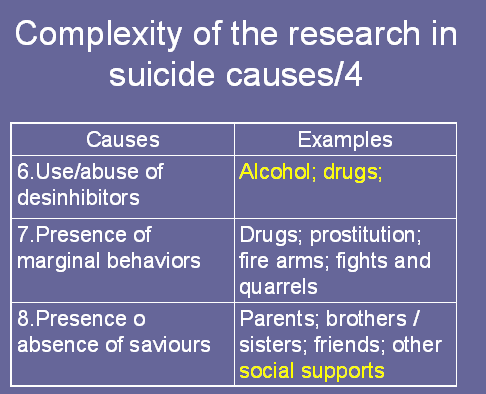
La Avispa. El veneno que me salvó
Claudia Aceves
Fecha Publicación: 12/07/2025
Alteraciones del sueño y sus consecuencias. Revisión.
Francisco Acoidan Rodríguez Batista et. al
Fecha Publicación: 18/05/2025
Conductas autolesivas sin intención suicida en pacientes con y sin diagnóstico de trastorno de personalidad
Mateo Gallego Restrepo et. al
Fecha Publicación: 18/05/2025
Duelo por suicidio: un dolor que se multiplica
Ana Luisa Regueira Fuenteseca et. al
Fecha Publicación: 18/05/2025
El Abordaje Psicológico en la Postvención del Suicidio: Estrategias Terapéuticas para el Duelo
Teresa Pérez Poo et. al
Fecha Publicación: 18/05/2025
Rol del médico de atención primaria en la Postvención: Detección precoz y seguimiento a largo plazo de familiares y allegados supervivientes
Anna Diusekova et. al
Fecha Publicación: 18/05/2025